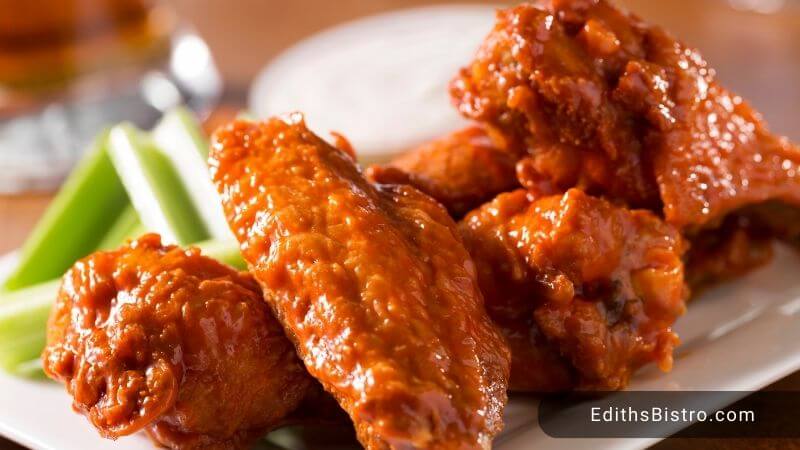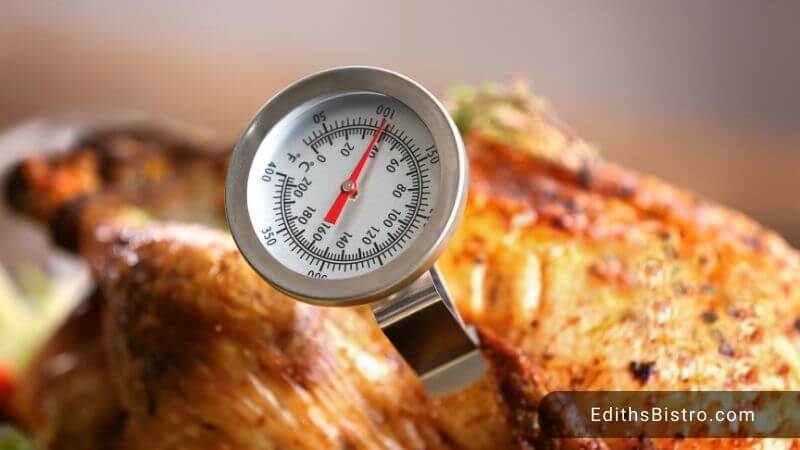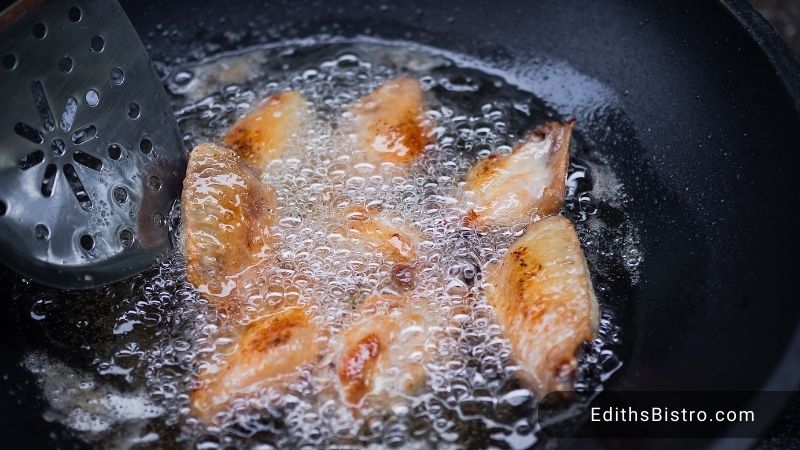Are you looking for the minimum internal temperature for chicken wings? We have the answer and beyond!
Discover the best tips for achieving deliciously cooked chicken wings with and without a thermometer!
What Is The Minimum Internal Cooking Temperature For Chicken Wings?
The minimum temperature to ensure your chicken wings can be eaten is 165°F (74°C). The interior of the chicken wings must reach this level of heat to eliminate pathogens like Salmonella, commonly found in poultry.
Yet, based on your preference, there might be better temperatures. Let’s find out!
What Is The Ideal Minimum Internal Temperature For Chicken Wings?
According to American Test Kitchen, wings are technically white meat yet fattier. Therefore, the perfect internal temperature for cooking wings is 190-200 °F. The fat is rendered just enough to flavor your meat at this temperature, and the skins will get crispier. You just need to put some sauce over them, and bam – your perfect game snack is ready!

If you have leftover wings and want to heat them up, there is no benchmark here. Because your chicken is cooked through, your preference is the only parameter that matters. Yet, we find the comfortable temperature to eat the reheated wing with your bare hand is 140°F.
Best Way To Check Chicken Wing Temperature
A meat thermometer is the best and most precise way to check the minimum internal temperature for chicken wings. Here’s how to do it:
- Get your wings off the heat, whether on the grill, the oven, or frying oil.
- Probe your wings with the thermometer at the thickest part of the wings, i.e., the drummette.
- Wait until the number on your tool is stable-it usually takes just a few seconds.
- Read the temperature. If your wings are 165°F and above, you’re done!
- If your wings do not reach the right temperature, return them to the heat and redo the 1-4 step.
Tips And Tricks For Measuring The Internal Temperature For Chicken Wings

- Choose the Right Thermometer: Digital instant-read thermometers are the most accurate and quickest. Dial thermometers are also reliable but take a bit longer to register the temperature.
- Insert Correctly: Insert the thermometer’s probe into the thickest part of the chicken wing without touching the bone. The bone can give a higher reading, making you think the meat is done when it isn’t.
- Wait for Stability: After inserting the thermometer, wait a few seconds until the temperature reading stabilizes.
- Know the Minimum Temperature: The minimum internal temperature for chicken wings is 165°F (74°C).
- Test Multiple Pieces: Don’t assume all your wings are cooked because one is. Take the temperature of several wings from different parts of your cooking surface to ensure even cooking.
- Rest Your Chicken: After cooking, let your chicken rest for a few minutes. It allows the heat to redistribute evenly and increases the internal temperature slightly.
- Probe Your Oil (with frying chicken): Getting your oil to 375 °F before throwing in your chicken is ideal. This minimum internal temperature for chicken wings will ensure you have the juicy inside and crispy outside wing you long for!
- The Fall-Of-The-Bone Test: Courtesy of Epicurious, always twist one of your cooked wings. If your wings are perfectly cooked, you can pull the meat off easily.
A Few Problems With Taking Internal Chicken Wings’ Temperature With Thermometer
Taking the minimum internal temperature for chicken wings with a thermometer can present a few challenges:
- Small Size: Chicken wings are relatively small, making it difficult to insert the thermometer probe accurately without hitting the bone, which can give a false high reading.
- Variation in Size and Cooking: Wings can vary significantly in size and thickness. This means that even if they are cooked together, they might not all simultaneously reach the minimum internal temperature.
- Time-Consuming: Checking the temperature of each wing individually can be time-consuming, especially if you’re cooking a large batch.
Hence, you can time your perfect wings to save you time and effort!
Cooking Times Chart For Cooking Perfect Chicken Wings
We list out some of the most preferred methods to cook wings and the time range for you to use at your convenience!
| Cooking Method | Temperature | Cooking Time |
|---|---|---|
| Baking | 375°F (190°C) | 45-50 minutes |
| Baking | 400°F (205°C) | 40-45 minutes |
| Grilling | Not directly on the open flame, set to the side, with medium heat | 20-25 minutes |
| Deep Frying | 375°F (190°C) | 10-12 minutes |
| Broiling | – | 5-7 minutes per side |
| Slow Cooker | Low setting | 6-8 hours |
| Slow Cooker | High setting | 3-4 hours |
| Air Fryer | 380°F (193°C) | 24 minutes (12 minutes, flip, then another 12 minutes) |
| Instant Pot | High pressure | 10 minutes with 5 minutes of natural release |
As always, ensure the inside of your wings reaches at least 165 to ensure the quailty!
Visual Clues For Perfect Chicken Wings
You can also tell from visual clues whether your wings are ready to eat.

Firstly, the skin should be golden brown and crispy. Inside, your wings’ meat should be white, not pink, indicating it’s thoroughly cooked.
Keep in mind that visual cues can be misleading. You can also probe the wings with a thermometer and ensure it gets the magic number.
Tips For Best Chicken Wings
Generally speaking, we have three main factors that affect your cooked wings: the raw wings, the marinating (souce), and the cooking methods.
Here is a video for you to learn (and bookmark) on all of those factors!
Chef Frank Proto shares his buffalo wing recipe, emphasizing the need to dry the wings for crispiness. He demonstrates a unique sauce, frying the wings to perfection and serving them with blue cheese, carrots, and celery.
FAQs
What minimum internal temperature for chicken wings should I aim for when smoking?
When smoking chicken wings, aim for an internal temperature of 190-200°F (88-93°C) for the best combination of flavor and texture.
What’s the best way to measure the minimum internal temperature for chicken wings without a thermometer?
While a meat thermometer is the most reliable method, you can also do the twist test, time your wings, and tell from visual clues. However, those methods aren’t 100% accurate.
How long does it take for chicken wings to reach the minimum internal temperature?
The cooking time for chicken wings can vary depending on the cooking method and temperature. However, on average, chicken wings typically take about 20-30 minutes to reach the minimum internal temperature of 165°F (74°C) when baked or roasted in an oven.






![What To Pair With Quiche? 25+ Best Dishes [With Pictures]](https://www.edithsbistro.com/wp-content/uploads/2024/04/what-to-pair-with-quiche-160x90.jpg)
